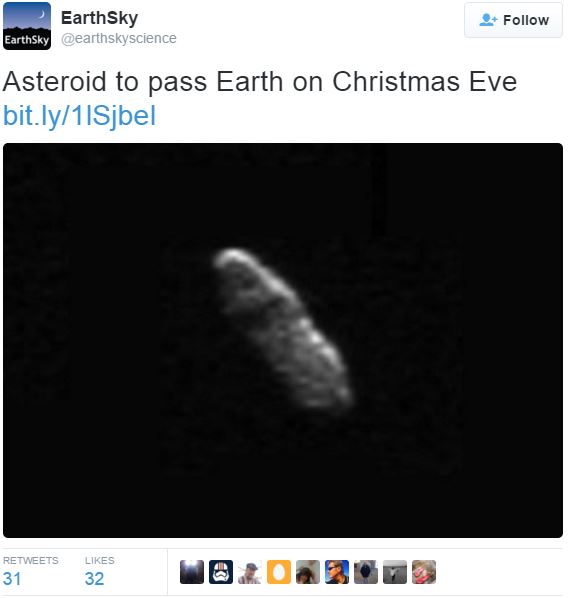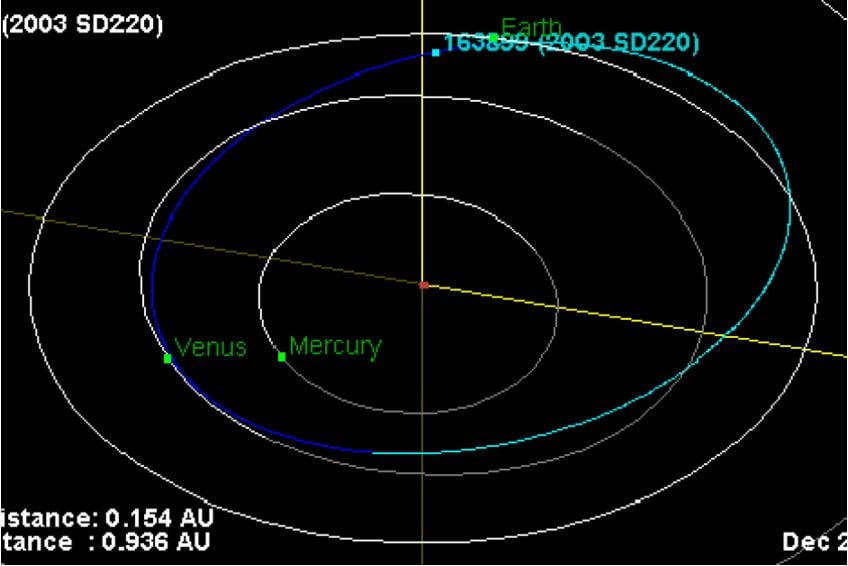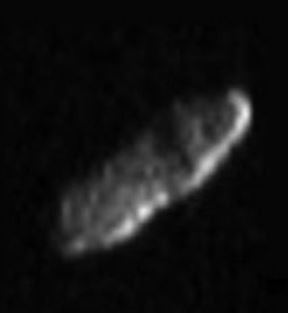A large asteroid will be whizzing past Earth fairly closely – astronomically speaking – on Christmas eve. There is no need for alarm, however, because asteroid 163899 (2003 SD220) will be 6.8 million miles away at its nearest point, which may seem very distant for us, but for astronomers and astrophysicists is just a stone’s throw away.
The asteroid is travelling at 16329.6 miles per hour, or 7.3 kilometres per second, 28 eight lunar distances away. One lunar distance is 384,400 km (238,900 mi), i.e. the distance from the Moon to the Earth.
As always occurs when a celestial being is predicted to fly by, there have been calamitous predictions about this asteroid on the Internet. Fortunately, none of those doomsday prophecies are true.
 What do you think? A potato or a chicken nugget? (Image: https://twitter.com)
What do you think? A potato or a chicken nugget? (Image: https://twitter.com)
Unfortunately, nobody will be able to see it. This rocky object, that has been described as potato-shaped or looking like a chicken nugget, is very dim, with a magnitude of just 16.9. To be able to see one with the naked eye, it must have a magnitude of 7 or lower (the scale works in reverse). The sun in the sky has a magnitude of (minus) -26.
Asteroid looks like a chicken nugget or potato
The Arecibo Observatory in Arecibo, Puerto Rico – an enormous radio and radar dish set in the middle of a rainforest – captured Doppler images of the asteroid. Upon seeing it, many in the media said it looked just like a chicken nugget or a potato.
Astronomy Now quoted Dr. Edgard Rivera-Valentin, Staff Planetary Scientist of the Universities Space Research Association (USRA) at Arecibo Observatory, as saying:
“After several days of radar observations, we find the asteroid to resemble a sweet potato, or batata, which is quite appropriate for the holiday season.”
Dr. Patrick Taylor, Group Lead for USRA for Planetary Radar at Arecibo Observatory, said:
“Because it comes close to Earth it is of interest to NASA as a possible future robotic or human mission target.”
 On Christmas Eve, the asteroid 2003 SD220 will be 6.8 million miles from Earth, its closest point. (Image: ssd.jpl.nasa.gov)
On Christmas Eve, the asteroid 2003 SD220 will be 6.8 million miles from Earth, its closest point. (Image: ssd.jpl.nasa.gov)
When our Solar System was formed, there were probably some leftovers. Scientists believe asteroids form part of these leftovers. They are of interest to NASA and other space agencies across the world because they may help us better understand how planets were formed.
Asteroids are whizzing relatively near to Earth all the time. Between now and the middle of February next year, there will be nineteen asteroid flybys within a one-hundredth of an astronomical unit. One astronomical unit is the distance between the Earth’s centre and the Sun’s centre (150 million kilometres or 93 million miles).
Over the next two months, there will be 250 celestial objects passing Earth within a distance of half an astronomical unit, says NASA’s Near Earth Object Program.
About asteroid 2003 SD220
Asteroid 2003 SD220 was discovered by the Lowell Observatory Near-Earth-Object Search (LONEOS), a NASA-run project at Anderson Mesa. LONEOS was a project designed to discover asteroids and comets that orbit near the Earth.
The asteroid is over 1.25 miles (2 km) long, and takes over 11 days to rotate once on its axis. It takes 275.2 days to complete one full orbit around the sun.
It makes its closest approach to Earth, 6.8 million miles (10.9 million km) distance, on Christmas Eve at 13:06 UT.
Video – NASA Images Show What Christmas Eve Asteroid Looks Like

